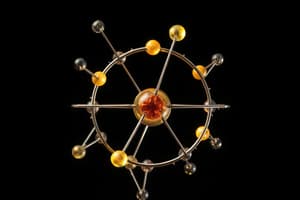Podcast
Questions and Answers
What is the hybridization state of carbon in all alkanes?
What is the hybridization state of carbon in all alkanes?
- sp
- dp3
- sp2
- sp3 (correct)
Which suffix is used for naming alkanes according to IUPAC nomenclature?
Which suffix is used for naming alkanes according to IUPAC nomenclature?
- -ene
- -yne
- -ol
- -ane (correct)
What property of alkanes explains their low solubility in water?
What property of alkanes explains their low solubility in water?
- Low polarity (correct)
- High polarity
- Ability to form hydrogen bonds
- High density
Which alkane corresponds to a carbon chain of six atoms?
Which alkane corresponds to a carbon chain of six atoms?
How do the boiling points of unbranched alkanes change with increasing molecular weight?
How do the boiling points of unbranched alkanes change with increasing molecular weight?
According to IUPAC rules, how should substituents be listed when naming a compound?
According to IUPAC rules, how should substituents be listed when naming a compound?
Which of the following is a common characteristic of alkane melting points?
Which of the following is a common characteristic of alkane melting points?
What is the parent name for an alkane with 10 carbon atoms?
What is the parent name for an alkane with 10 carbon atoms?
What characterizes a polar covalent bond?
What characterizes a polar covalent bond?
Which type of hybridization occurs when one s orbital and three p orbitals combine?
Which type of hybridization occurs when one s orbital and three p orbitals combine?
What type of bond do alkanes exclusively contain?
What type of bond do alkanes exclusively contain?
Which of the following is an example of sp² hybridization?
Which of the following is an example of sp² hybridization?
Which type of molecule can attract other polar molecules through hydrogen bonding?
Which type of molecule can attract other polar molecules through hydrogen bonding?
What is the general molecular formula for alkanes?
What is the general molecular formula for alkanes?
Which type of hydrocarbons are characterized by a cyclic structure?
Which type of hydrocarbons are characterized by a cyclic structure?
Which type of bond is considered the strongest in molecular structures?
Which type of bond is considered the strongest in molecular structures?
What is the general molecular formula for cycloalkanes?
What is the general molecular formula for cycloalkanes?
Which cycloalkane is a gas at room temperature?
Which cycloalkane is a gas at room temperature?
How are alkenes primarily identified?
How are alkenes primarily identified?
What happens to the boiling point of alkenes as their mass increases?
What happens to the boiling point of alkenes as their mass increases?
What type of hydrocarbon is characterized by at least one carbon-carbon triple bond?
What type of hydrocarbon is characterized by at least one carbon-carbon triple bond?
What is the effect of branching on the boiling point of alkenes?
What is the effect of branching on the boiling point of alkenes?
Which of the following is a characteristic of cis alkenes compared to trans alkenes?
Which of the following is a characteristic of cis alkenes compared to trans alkenes?
How are the names of cycloalkanes formed?
How are the names of cycloalkanes formed?
What defines an internal alkyne?
What defines an internal alkyne?
How are the carbon atoms in a carbon-carbon triple bond hybridized?
How are the carbon atoms in a carbon-carbon triple bond hybridized?
What suffix is used in the nomenclature of alkynes?
What suffix is used in the nomenclature of alkynes?
What is the primary reason alkynes are soluble in nonpolar solvents?
What is the primary reason alkynes are soluble in nonpolar solvents?
What characteristic of alkynes contributes to their strength compared to alkenes and alkanes?
What characteristic of alkynes contributes to their strength compared to alkenes and alkanes?
What is a characteristic feature of aromatic hydrocarbons?
What is a characteristic feature of aromatic hydrocarbons?
Which prefix is used to indicate that there are two identical substituents on a benzene ring?
Which prefix is used to indicate that there are two identical substituents on a benzene ring?
What can be concluded about the solubility of alkynes in water?
What can be concluded about the solubility of alkynes in water?
What determines the atomic number of an element?
What determines the atomic number of an element?
How does electronegativity affect covalent bonds?
How does electronegativity affect covalent bonds?
What type of bond is formed when Na loses an electron and Cl gains an electron?
What type of bond is formed when Na loses an electron and Cl gains an electron?
Which of the following statements about orbitals is correct?
Which of the following statements about orbitals is correct?
What causes an atom to become a cation?
What causes an atom to become a cation?
On Pauling’s Electronegativity Scale, which element is considered the most electronegative?
On Pauling’s Electronegativity Scale, which element is considered the most electronegative?
Which describes a nonpolar covalent bond?
Which describes a nonpolar covalent bond?
What is the relationship between protons and neutrons in an element’s mass number?
What is the relationship between protons and neutrons in an element’s mass number?
Flashcards are hidden until you start studying
Study Notes
Structure and Bonding
- Atoms consist of a nucleus with protons and neutrons, surrounded by electrons.
- The number of protons determines the atomic number.
- The mass number is the sum of protons and neutrons in the nucleus.
- Electrons reside in orbitals, grouped in shells (s, p, d, f).
- The first shell (n=1) has only an s orbital (1s).
- The second shell (n=2) has s and p orbitals (2s and 2p).
- The third shell (n=3) has s, p, and d orbitals (3s, 3p, and 3d).
Electronegativity
- Electronegativity is an atom's ability to attract electron density in a covalent bond.
- Higher values indicate a more electronegative element.
- Fluorine is the most electronegative element with an electronegativity value of 4.0.
Ionic Bonds
- Formed by electron transfer between a metal (cation) and a nonmetal (anion).
- The metal loses electrons becoming positively charged (cation).
- The nonmetal gains electrons becoming negatively charged (anion).
Covalent Bonds
- Involve the sharing of electrons between two atoms.
- Nonpolar covalent bonds occur when electrons are shared equally.
- Polar covalent bonds occur when electrons are shared unequally, resulting in partial positive and negative charges on the atoms.
Hydrogen Bonding
- A specific type of dipole-dipole interaction.
- Occurs between molecules with a slightly negative atom (e.g., oxygen) and a slightly positive hydrogen atom.
- It is a weaker bond than a covalent bond but plays a crucial role in biological systems, such as water.
Hybridization
- Involves mixing atomic orbitals of equal energy levels to form a new set of hybrid orbitals.
- Sp3 hybridization: One s orbital and three p orbitals combine to form four sp3 hybrid orbitals with tetrahedral geometry (e.g., methane, CH4).
- Sp2 hybridization: One s orbital and two p orbitals combine to form three sp2 hybrid orbitals with trigonal planar geometry (e.g., ethene, C2H4).
- Sp hybridization: One s orbital and one p orbital combine to form two sp hybrid orbitals with linear geometry (e.g., ethyne, C2H2).
Hydrocarbons
- Contain only carbon and hydrogen atoms.
- Aliphatic hydrocarbons include straight chains, branched chains, and cyclic structures.
- Aromatic hydrocarbons consist of cyclic structures with alternating double and single bonds.
- Saturated hydrocarbons have only single bonds.
- Unsaturated hydrocarbons contain at least one double or triple bond.
Alkanes
- Saturated hydrocarbons with the general formula CnH2n+2.
- Contain only single bonds between carbon atoms.
- Carbon atoms are sp3 hybridized.
- Examples: methane, ethane, propane, butane.
Nomenclature of Alkanes
- The longest continuous chain of carbon atoms is the parent chain.
- The parent is named based on the number of carbon atoms (meth, eth, prop, but, etc.).
- The suffix -ane denotes an alkane.
- Substituents are named and numbered according to their position on the parent chain.
Physical Properties of Alkanes
- Nonpolar and insoluble in water due to their low polarity and inability to form hydrogen bonds.
- Less dense than water.
- Boiling points increase with increasing molecular weight.
- Melting points increase with increasing carbon atoms.
Cycloalkanes
- Saturated hydrocarbons with the general formula CnH2n.
- Contain a ring of carbon atoms.
- Each carbon atom is sp3 hybridized.
- Examples: cyclopropane, cyclobutane, cyclopentane.
Nomenclature of Cycloalkanes
- "Cyclo" prefix is added to the name of the alkane with the same number of carbon atoms.
- Substituents are named and numbered based on their positions on the ring.
Physical Properties of Cycloalkanes
- Cycloalkanes are considered nonpolar.
- They dissolve in nonpolar solvents.
- They have higher melting and boiling points compared to their corresponding n-alkanes, due to their symmetry and hindered rotation.
Alkenes
- Unsaturated hydrocarbons containing at least one carbon-carbon double bond.
- General formula: CnH2n (for non-cyclic alkenes) and CnH2n-2 (for cyclic alkenes).
- Also known as olefins.
- The functional group is the carbon-carbon double bond, which is reactive.
Nomenclature of Alkenes
- The longest continuous chain including the double bond becomes the parent chain.
- The suffix "-ane" changes to "-ene" to denote an alkene.
- The chain is numbered so that the double bond has the lowest possible number.
Physical Properties of Alkenes
- Boiling points increase with increasing molecular weight.
- They are less dense than water.
- They are slightly polar due to the polarizable pi bond.
- Cis isomers have higher boiling points than trans isomers due to their greater dipole moment.
Alkynes
- Unsaturated hydrocarbons containing at least one carbon-carbon triple bond.
- General formula: CnH2n-2
- Examples: ethyne (acetylene), propyne, butyne.
- Alkynes are classified as terminal or internal based on the position of the triple bond.
Electronic Structure of Alkynes
- Each carbon atom in the triple bond is sp hybridized.
- The sp hybrid orbitals form a sigma bond (180⁰) between the carbon atoms.
- The two remaining p orbitals on each carbon form two pi bonds, perpendicular to the sigma bond.
Nomenclature of Alkynes
- "-yne" suffix indicates an alkyne.
- The triple bond is assigned the lowest possible number in the chain.
Physical Properties of Alkynes
- Similar physical properties to their corresponding alkanes.
- Lower than four carbons (except 2-butyne) are gases at room temperature.
- Nonpolar and dissolve in nonpolar solvents.
- Slightly soluble in water.
Arenes (Aromatic Compounds)
- Cyclic hydrocarbons with alternating double and single bonds between carbon atoms forming a planar hexagonal ring.
- Example: benzene.
Nomenclature of Arenes
- Monosubstituted benzenes: Benzene is sometimes the parent name with a substituent prefix, or combined with the substituent for a new parent name.
- Polysubstituted benzenes: Numbers indicate the position of substituents on the ring. Prefixes are used to indicate the number of identical substituents.
Studying That Suits You
Use AI to generate personalized quizzes and flashcards to suit your learning preferences.



